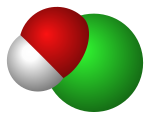
Back حمض الهيبوكلوروز Arabic هیپوکولورو اسید AZB Хларнавацістая кіслата Byelorussian Àcid hipoclorós Catalan Kyselina chlorná Czech Хлорларахкка йӳçек CV Hypochlorige Säure German Υποχλωριώδες οξύ Greek Hipoklorita acido Esperanto Ácido hipocloroso Spanish

| |
 | |
| Names | |
|---|---|
| IUPAC name
Hypochlorous acid
| |
Other names
| |
| Identifiers | |
3D model (JSmol)
|
|
| ChEBI | |
| ChemSpider | |
| ECHA InfoCard | 100.029.302 |
| EC Number |
|
PubChem CID
|
|
| UNII | |
CompTox Dashboard (EPA)
|
|
| |
| |
| Properties | |
| HOCl | |
| Molar mass | 52.46 g·mol−1 |
| Appearance | Colorless aqueous solution |
| Density | Variable |
| Soluble | |
| Acidity (pKa) | 7.53[1] |
| Conjugate base | Hypochlorite |
| Hazards | |
| Occupational safety and health (OHS/OSH): | |
Main hazards
|
corrosive, oxidizing agent |
| GHS labelling: | |
| H320, H335 | |
| P301+P330+P331, P302+P352, P304+P340, P305+P351+P338 | |
| NFPA 704 (fire diamond) | |
| Safety data sheet (SDS) | chemfresh.com |
| Related compounds | |
Other anions
|
|
Related compounds
|
|
Except where otherwise noted, data are given for materials in their standard state (at 25 °C [77 °F], 100 kPa).
| |
Hypochlorous acid is an inorganic compound with the chemical formula ClOH, also written as HClO, HOCl, or ClHO.[2][3] Its structure is H−O−Cl. It is an acid that forms when chlorine dissolves in water, and itself partially dissociates, forming hypochlorite anion, ClO−. HClO and ClO− are oxidizers, and the primary disinfection agents of chlorine solutions.[4] HClO cannot be isolated from these solutions due to rapid equilibration with its precursor, chlorine.
Because of its strong antimicrobial properties, the related compounds sodium hypochlorite (NaOCl) and calcium hypochlorite (Ca(OCl)2) are ingredients in many commercial bleaches, deodorants, and disinfectants.[5] The white blood cells of mammals, such as humans, also contain hypochlorous acid as a tool against foreign bodies.[6] In living organisms, HOCl is generated by the reaction of hydrogen peroxide with chloride ions under the catalysis of the heme enzyme myeloperoxidase (MPO).[7]
Like many other disinfectants, hypochlorous acid solutions will destroy pathogens, such as COVID-19, absorbed on surfaces.[8] In low concentrations, such solutions can serve to disinfect open wounds.[9]
- ^ Harris, Daniel C. (2009). Exploring Chemical Analysis (Fourth ed.). p. 538.
- ^ "Hypochlorous acid". CAS Common Chemistry. CAS, a division of the American Chemical Society, n.d. CAS RN: 7790-92-3. Retrieved 2022-04-12.
- ^ "hypochlorous acid". Chemical Entities of Biological Interest. European Bioinformatics Institute. CHEBI:24757. Retrieved 2022-04-12.
- ^ Sansebastiano, G. et al. Page 262 in Food Safety: A Practical and Case Study Approach (Ed: R. J. Marshall) 2006, Springer Science & Business Media, Berlin.
- ^ Block, Michael S.; Rowan, Brian G. (September 2020). "Hypochlorous Acid: A Review". Journal of Oral and Maxillofacial Surgery. 78 (9): 1461–1466. doi:10.1016/j.joms.2020.06.029. ISSN 0278-2391. PMC 7315945. PMID 32653307.
- ^ "Treating Chronic Wounds With Hypochlorous Acid Disrupts Biofilm". Today's Wound Clinic. Retrieved 2021-02-08.
- ^ Ghoshal K, et al. (July 2016). "A novel sensor to estimate the prevalence of hypochlorous (HOCl) toxicity in individuals with type 2 diabetes and dyslipidemia". Clinica Chimica Acta. 458: 144–153. doi:10.1016/j.cca.2016.05.006. PMID 27178483.
- ^ US EPA, OCSPP (2020-03-13). "List N: Disinfectants for Coronavirus (COVID-19)". US EPA. Retrieved 2021-02-08.
- ^ "Pure Hypochlorous Acid: A Primer on pH and Wound Solutions". WoundSource. 2020-11-05. Retrieved 2021-02-08..
© MMXXIII Rich X Search. We shall prevail. All rights reserved. Rich X Search
